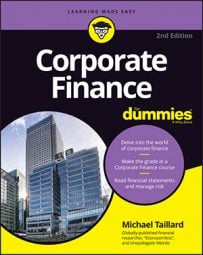Because the risk of a single investment can’t be totally eliminated, corporations attempt to reduce the risk of a portfolio by picking investments that are likely to change in value in different ways or at different times. This process is called diversification. Diversification means taking advantage of differences in risk among your investments. Investments tend to change in value at different times and even in different directions.
So if your portfolio consists of several different investments and only one of them loses value, the portfolio loses a smaller percentage of its value than does that single investment.
Here’s a theoretical example with an extremely low probability of actually happening. Say that a corporation holds two investments, and these two investments change in value in exactly opposite ways. So if one decreases in value by 1 percent, the other increases in value by 1 percent.
Between the two investments, any changes in value result in not only zero gain but also zero risk. The goal of diversification is to reduce risk by finding several investments that change in value at different times, in response to different events, by different percentages, or in completely different directions (as in the preceding example).
By doing this, you reduce the severity of any losses that may occur in a portfolio from the risk associated with only one investment. You can actually mathematically measure the effectiveness of portfolio diversification.
Now, you may ask yourself why corporations don’t just invest all their money in only the best assets. If you diversify your portfolio by investing in a number of different assets, that means you’re investing money in assets that are not your first choice. The opportunity cost of purchasing an investment intended to diversify a portfolio is the returns generated by the best investments that you could have spent that money on instead.
Warren Buffet, CEO of Berkshire Hathaway Inc. and one of the richest people in the world as a result of his investments, claims that diversification is used only when a corporation lacks confidence or ability, maintaining that diversification is a tool for the incompetent (though Mr. Buffet is a bit more tactful about it).
This criticism holds an important distinction: Diversification simply for the sake of diversification is not very helpful.
Yet even Mr. Buffet holds investments in at least 54 companies, far more than your average investor, through Berkshire Hathaway (which buys ownership in other companies). The point of diversification is to reduce the risk to your portfolio more than you reduce the returns. Following is a quick example:
Say that Investment A generates 10 percent annual returns, Investment B generates 5 percent annual returns, and your portfolio has an equal split between Investment A and Investment B. X is the amount of portfolio risk as a percentage of total value. In the case of this example, 7.5 percent is the amount of annual returns generated by the portfolio (10% + 5% = 15% / 2 = 7.5%).
Here’s what you can deduce from this example:
If X = 7.5%: Obviously Investment A generates 100 percent more returns per year, but the actual importance of this depends on the amount of risk. If Investment B reduces risk, then the change in risk is the same as the difference in returns between A and B.
If X > 7.5%: If diversifying risk means that the total risk of the portfolio stays above 7.5 percent, then the amount of returns generated decreases at a faster rate than diversifying risk. In other words, the portfolio is being diversified poorly, taking on more risk for the amount of returns being generated.
If X < 7.5%: If the portfolio has less than 7.5 percent risk through diversification, then it’s generating more returns for the amount of risk being incurred because risk is decreasing at a faster rate than returns. This scenario is considered an effective use of diversification.
The point is that you want to look for the best investments you can find and then diversify by purchasing those investments that provide the highest returns but risk losing value under opposite conditions.
For example, stocks tend to increase in value when interest rates decrease, whereas variable rate bonds decrease in value under the same conditions. Putting the two together in a portfolio, then, would be a good choice for reducing risk through diversification, assuming that both investments were good choices individually as well.

